Sometimes, a car company will bring out a new model so appealing it winds up costing sales.
This new Taos from VW, for instance.
It’s less expensive than the VW Tiguan – and roomier, too.
Did we mention that it gets better gas mileage on top of that? And comes standard with features like the Digital Cockpit instrument cluster that up to now has only been available in the most expensive version of the Tiggy?
So, what’s the catch?
What It Is
The Taos is VW’s newest model – and smallest, most affordable new crossover.
But it’s only smaller – on the outside – than the Tiguan, VW’s formerly smallest and most affordable crossover.
You can pick up a new base S trim/FWD Taos for $22,995 to start; $25,040 with the optional 4Motion AWD system – vs. $25,995 to start for the least expensive (and FWD) version of the Tiggy. Which doesn’t come with more second row leg or cargo room than the Taos . . . even though it’s about 10 inches longer, bumper-to-bumper.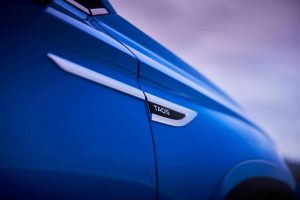
So what do you get in return for paying more – for the Tiggy?
Well, there is a third row – which comes standard in the Tiggy.
The Taos doesn’t offer that.
There’s also more standard engine in the Tiggy.
VW’s next-largest crossover – on the outside – comes equipped with a bigger, 2.0 liter engine that makes more power than the 1.5 liter engine that’s the only available engine in the Taos.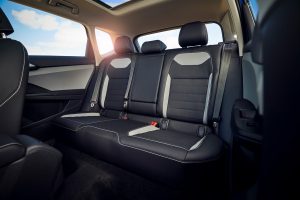
But its prices top out at $33,045 for an SEL trim with 4Motion AWD.
As opposed to $36,595 for a top-of-the-line Tiggy SEL R-Line with 4Motion AWD.
Which is also by the way the only version of the Tiggy that comes standard with the Digital Cockpit instrument cluster that’s standard in the $22,995 to start Taos.
What’s New
The Taos is the newest VW model, nominally intended to box with the other small crossovers its price range such as the Mazda CX-30, Kia Seltos, Subaru Crosstrek and Honda HR-V.
But its features – and space for the price – inevitably invite cross-shop comparisons with its higher-priced – but less spacious – sibling.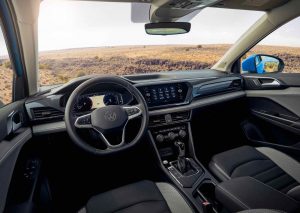
What’s Good
More for your money – literally.
Almost as easy on gas in city driving as the Tiggy is on the highway.
Two available automatic transmission – neither of them a CVT automatic.
What’s Not So Good
Not as much engine as you can get in rivals like the Seltos and Mazda CX-30.
No manual transmission option (the Subaru Crosstrek comes standard with a manual).
Not as many seats as you get in the Tiggy.
While the Taos is big for its size in terms of passenger and cargo room, it’s smaller than most under the hood.
In terms of displacement.
The standard 1.5 liter four cylinder engine is smaller than the 2.0 liter engines that are standard in the Kia Seltos and Subaru Crosstrek – as well as the 1.8 liter engine that’s standard in the Honda HR-V . . . and much smaller than the 2.5 liter engine that you’ll find under the hood of the Mazda CX-30.
But it punches above its weight.
158 horsepower is advertised – which is more horsepower than the 141 horses summoned by the Honda HR-V’s larger 1.8 liter engine and the 146 horsepower emanating from the Kia’s even larger 2.0 liter engine. It also edges out the 152 horsepower conjured by the Crosstrek’s standard 2.0 liter engine.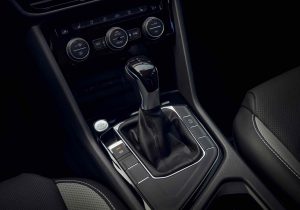
It’s not as much as the 186 horsepower developed by the Mazda’s 2.5 liter engine – which is the largest – and strongest – standard engine in this class.
But have a look at the other side of the ledger.
The little VW four makes almost exactly as much torque as the Mazda’s much bigger four – 184 ft.-lbs. vs. 186 – and it makes it almost immediately, at 1,750 RPM vs. at a much higher 4,000 RPM. This being a function of the VW’s four being fitted with a turbocharger while the Mazda’s four isn’t.
More specifically, of it being a variable geometry turbocharger. This being an interesting take on the turbocharging idea.
The pressure of the exhaust stream that drives the turbo – and eventually produces the boost in a conventionally turbocharged engine – is increased at low engine RPM – when there isn’t as much exhaust flow, yet – by changing the angle of the vanes within the turbo.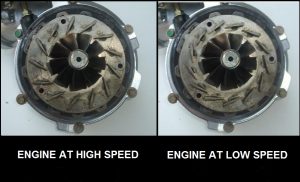
It works kind of like variable pitch propellers used in many aircraft to adjust the airflow.
It provides the same low-RPM boost achieved by twin scroll turbos used by other makers of turbocharged engines such as BMW that scavenge the exhaust pulses of individual ports that are actively exhausting rather than – as was formerly usual – waiting for the exhaust gas pressure to build from all of the exhaust ports, together. Which formerly meant a moment or two before sufficient exhaust pressure developed to spin the turbo’s internals and make the boost that results in more horsepower – and torque.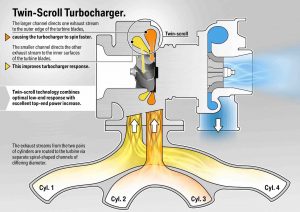
By snugging the turbo as close as possible to the exhaust ports and channeling the exhaust gasses of actively exhaling exhaust ports – or altering the geometry of the vanes within the turbo – the lag formerly associated with turbocharging is greatly diminished while low-end power production is greatly enhanced.
Twin scroll and variable geometry turbocharging have made turbocharged engines mainstream engines.
Formerly, they were for the most part high-performance engines. Because they were peaky engines, defined by a sudden rush of boosted power – which came after a lag in power. This was desirable in a performance car because it gave the car character – a wild side. But it wasn’t as desirable in a day-to-day car, where peaky power delivery is a problem.
Here, it isn’t.
The Taos scuttles to 60 in about 7.4 seconds – which puts it at the top of its class. The Kia Seltos – with its standard 2.0 liter engine (and no turbo) takes about 10 seconds to reach the same speed; the Honda HR-V (which comes with only the 1.8 liter engine) takes about 9 seconds, which is about as long as it takes the base-engined Subaru Crosstrek.
Another plus in the VW’s favor is bigger mileage, a function of is smaller engine.
It rates 28 MPG in the city and 36 on the highway for the FWD version vs. 28 city, 34 highway for the Honda HR-V and 29 city, 35 highway for the Seltos equipped with its standard 2.0 liter four. The bigger-engined Mazda CX-30 also comes in smaller when it comes to MPGs – 25 city, 33 highway.
The manual-equipped Crosstrek only manages 22 city and 29 highway – but it is available with a manual. (AWD is also standard).
Everything else in this class is only available with an automatic, including the Taos.
But, the VW’s automatics – plural – are not continuously variable (CVT) automatics, as are the Crosstrek’s optional automatic and the Honda HR-V’s only automatics. CVT automatics aren’t popular with some buyers on account of their lack of shifting in favor of ranges, varying. It doesn’t feel right to some – and some don’t like the usually greater driveline noise that often comes with CVTs, which hold the engine in a higher RPM range when accelerating.
The front wheel drive Taos comes standard with an eight speed automatic while models with equipped with 4Motion AWD get a seven-speed dual-clutch automatic. Both shift but the dual clutch box can shift faster, for a sportier feel.
On The Road
While you can get more power in some of the others in this class – most notably the Mazda CX-30, which is available with a 250 horsepower turbocharged engine (the strongest available engine in the class) the Taos has the most most powerful standard engine – and the best standard performance.
Which feels like even more than it is, courtesy of the almost-immediate torque peak summoned by the variable geometry turbo.
It’s diesel-like in that it’s not necessary to rev it to get the Taos going. But it doesn’t cost as much as a diesel, either to buy it or to fuel it.
Diesel now costs significantly more than regular unleaded gas – which is all you’ll need to feed this VW, since it does not require premium unleaded gas fuel to make its maximum advertised horsepower or torque (the Mazda’s turbo-boosted optional engine does need it).
Also diesel-like is this VW’s higher-than-advertised gas mileage.
Over the course of a weeklong test drive, the tested Taos approached 40 on the highway when driven moderately, at 65-70 MPH. Which reminded this reviewer of the no-longer-available TDI diesel engines VW used to offer that always delivered better-than-advertised MPGs.
It’s sad that VW was practically crucified over the hugely over-stated “cheating” on government emissions certification tests, which didn’t amount to a hill of beans in terms of befouling the air we breath.
VW’s diesels were not “dirty.”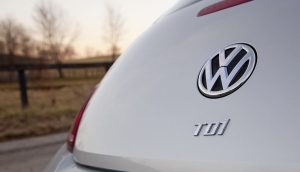
They were too efficient.
A TDI-powered Jetta or Golf could – did – exceed 50 MPG on the highway, which was nearly as efficient as a hybrid car and much more affordable (and practical) than an electric car.
And that’s why they had to go.
But VW has brought them back – in a sense. This little variably-turbo’d four in the Taos will cost you about the same as what a TDI-powered Jetta used to cost, before it got banned. While it might not give you 50-plus MPG, it won’t cost you 30 cents more per gallon to fuel it, either.
It’s also nice – per what was mentioned earlier – about the Taos not being afflicted with a CVT automatic, especially since its gas mileage numbers are better than those of its CVT-equipped rivals.
But drive both automatics before you decide which to buy.
The standard eight speed automatic may not shift as quickly as the seven speed dual clutch automatic that’s standard in 4Motion-equipped versions of the Taos – but it shifts more smoothly. Dual clutch automatics are designed to make gear changes almost instantaneously, which enhances the sporty-snappy feel of a vehicle.
But not everyone likes sporty-snappy.
Gas mileage also goes down some in models equipped with the seven speed automatic, to 25 city/32 highway – though to be fair that is probably mostly due to the additional 200-something pounds of curb weight that comes along for the ride, courtesy of the 4Motion AWD.
Nothing stands out, especially, about the appearance of the Taos. It looks pretty much like the Tiggy, with some slight tweaks here and there intended to be evocative of the Atlas, VW’s biggest crossover, period.
The differences are inside.
You won’t find the third row that’s standard in the Tiggy. But you will find 27.9 cubic feet of space for cargo behind the second row in the Taos – which is more than twice as much space for cargo as there is behind the Tiggy’s third row (12.0 cubic feet). If you lower the second row in the Taos, the space for stuff opens up to 65.9 cubic feet which is still more space than in the Tiggy (65.3 cubic feet) even with both of its rows folded.
You also get more second row legroom – 37.9 inches vs. the Tiggy’s 36.6 inches. It’s not a small difference given the 10.3 inches in length, Taos (175.8 inches) vs. Tiggy (186.1 inches).
The Taos also comes out bigger vs. same-length rivals like the Mazda CX-30 (20.2 cubic feet behind its second row; 52.7 with its seats folded) and the Soobie Crosstrek (20.8 cubic feet behind its second; 55.3 cubic feet total).
The Honda HR-V come closer, capacity-wise (each of them within about 3 cubic feet of the VW in both categories) but lacking the VW’s punchier standard performance and the VW’s top-of-its class gas mileage.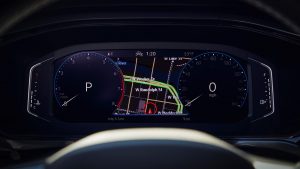
Some other things that set the Taos apart are its standard digital instrument cluster – a feature formerly offered only in much more pricey VWs, like the Tiggy SEL R-Line. Detracting from its otherwise attractive roster of features-for-the-money is that the base S trim comes with a mere four speaker stereo.
To get six speakers, you have to move up the food chain to the SE, which also comes with two other features that ought to be standard in a 2022 model year anything – AppleCarPlay and Android Auto.
One thing that’s not standard – and be thankful for it – is VW’s suite of driver “assistance” technology, styled IQ Drive. If you want your driving to be “assisted” by such things as Forward Collision Mitigation, Lane Keep Assist and even an “emergency assistance” feature that will stop and park the car and engage the hazard blinkers if the car decides you’re not “responsive” enough to drive – you are free to buy the IQ bundle, which adds $995 to the cost of a Taos.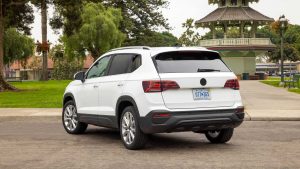
But you are free to skip this cost – and the “assistance” – which is almost enough to justify buying a Taos, all by itself.
The Bottom Line
This newest VW stands out from the pack.
It might stand out too much for the Tiggy’s good, too.
. . .
Got a question about cars, bikes, Libertarian politics – or anything else? Click on the “ask Eric” link and send ’em in! Or email me at [email protected] if the @!** “ask Eric” button doesn’t work!
If you like what you’ve found here please consider supporting EPautos.
We depend on you to keep the wheels turning!
Our donate button is here.
If you prefer not to use PayPal, our mailing address is:
EPautos
721 Hummingbird Lane SE
Copper Hill, VA 24079
PS: Get an EPautos magnet or sticker or coaster in return for a $20 or more one-time donation or a $10 or more monthly recurring donation. (Please be sure to tell us you want a magnet or sticker or coaster – and also, provide an address, so we know where to mail the thing!)
My eBook about car buying (new and used) is also available for your favorite price – free! Click here. If that fails, email me at [email protected] and I will send you a copy directly!


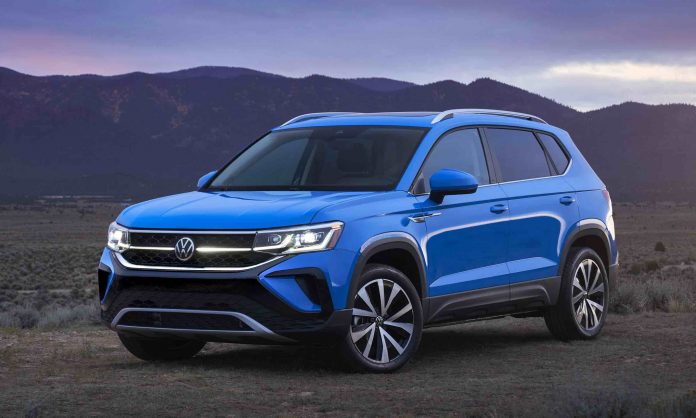


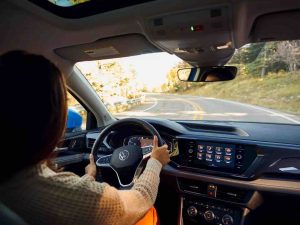
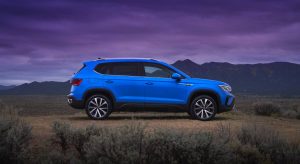
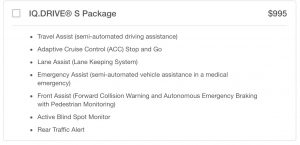








Great review Eric. VW has been making the best cars of the modern era for a while IMO. Simple clean interiors and dash (not sure about the digital cockpit thing) great site lines for a modern car, and whats-not-to-like exterior design. All screwed together with a solid feeling of teutonic quality. A manual option sure would have been nice here but alas us plebes arent allowed that anymore. I have a crosstrek because of that but if I was ever back in the market might have to take a look at this one. Its actually nice you can get these without AWD. In phoenix theres no need for it.
Thanks, Mark!
I feel as you do. I’d pick the Crosstrek over the Taos only because it offers a manual (if you can find a dealer who will order one). But the Taos is a very close second…
Yes, a great review of a great car! It’s been a while since I posted, but we have a 2018 Golf Sportwagen which sounds very, very similar. Did they have the advanced turbocharger back then? It sure drives like it. It makes getting on the freeway such a blast.
The Sportwagen is a station wagon version of the Taos, it sounds like. Insane gas mileage. It makes time. So classy, inside and out. It pops when you drive it, sticks to curves.
Oh, and the Sportwagen of 2018 retailed at the same price points. But they had a manual version, which didn’t sell at all. We got ours for $18K.
Yeah, everything you described (save for a very nice analog instrument panel), but with a stick, for $18K. We did add the “platinum” service package, so when spare parts take a long time to arrive, VW will pay for a rental for us. That brought the price back up to $22K, along with significant peace of mind. Life is good.
I’m originally from Oregon but now living in Australia.
2005 Golf V, 2.0 TDI (South African build)..5 years, sold
2010 Polo 1.6 TDI (believe Slovakian build)..2 years, sold
2019 Polo 1.0 TSI (South African build)….current
We have a few vehicle that a comparable to the Taos, but slightly different..T Roc and T Cross
The T Roc is a jacked up polo, we only get the 1.0 TSI…retails for ~$21K. Beginning to be popular.
The T ROK is the pervious golf, jacked up. Not very popular.
Our Tiguan is still available in Diesel….which is cool. About $42K new. It’s VAG most popular model, now outpacing everything.
I’m I the only one who saw the headline and read, “VW Tacos”?
anon 1
I like VAG products I own four of them.
VW Taos:
No CVT, great fuel economy, good power output, good performance, can skip some assists, uses regular gas, lots of room, sounds great.
This engine is better then the Honda 1.5 turbo used in some of their cars, the Honda had oil dilution problems.
VW diesel:
All the car companies were cheating on emissions, VW was targeted because it was number 1 in sales worldwide (kill them off to protect domestic manufacturers).
If peak oil is true diesel is better it is 30% more efficient (gas engines waste 30% more fuel, it isn’t burnt so goes out the tailpipe).
VW made a lightweight diesel hybrid that got almost 300 mpg, that was a better solution then EV’s.
A Mk4 VW Jetta could get over 50 mpg on the Highway, with a huge range.
A Mk 1 VW 1800 lb., was fitted with a Mk 4 turbo diesel, it was fast, 0 to 60 in about 6 seconds and got 65 mpg highway. That is better then an EV in lots of ways.
The VW 4 cyl 1.9 lt. diesel was so good it was swapped into lots of small trucks, etc., more then 450 lb ft torque possible, great fuel economy, can last 500,000 miles.
Gasoline engines produce around 40 percent more carbon dioxide (CO2) than diesel engines, catalytic converters cannot reduce the CO2 produced by the engine.
Diesel engines emit more N2O and CH4 then gas engines but there are measures that can be taken to reduce diesel emissions. Diesel fuel catalysts, catalytic converters, and particle filters can reduce emissions greatly.
The air coming out of the tailpipe on a modern diesel is cleaner then the air in a big city.
The GAIA religion/green/globalist/ one world government killed the diesel over N2O and the gas engine soon over CO2, they say zero emissions is the law soon, the exhaust coming out of an ICE engine is something like .00001% pollutants but that is higher then 0%, so they will be banned, this is insanity.
EV’s aren’t zero emissions either, they are remote emissions and have a dozen other far bigger issues, including pollution (production and recyling), safety, cost, charging time, weight, battery life, not enough chargers, grid can’t supply the electricity = insanity, etc. .
The odds are over 0% that there is a huge agenda that has nothing to do with global warming. You will own nothing, gates will drive his 959 Porsche.
With you on all points Anon.
I have 4 VAG products on my property, 2014 Cayenne Diesel, 2016 Tiggy, 2018 Atlas and my 2021 718 Cayman. Nothing else satisfies.
My Diesel Porsche (Sounds odd but the car is all Porsche, Hurley showed me that at the Brumos Driveing Experience – sadly defunct) but even after the “fix” the thing does 35 on the highway, but the good part is nearly 30 gallons – do the range math. I drove from Jacksonville Fl to Denver CO and got fuel one time only. There is no way TPTB will allow us to have that sort of free range therefor they had to go. They will never allow us to traverse across the country on a barrel of used french fry oil!
Anyway I was disappointed VW did not see fit to treat us to the T-Roc. But then VW’s US marketing department seems to me to be the picture of incompetence.
I have wondered what the car manufacturers would have come up with if they were going after customer wishes vs fulfilling government mandates.
I’m guessing turbos wouldn’t have been it though….
Even if crossovers had become popular on their own, this model would likely have a nice medium sized V6, and likely start under 20k.
Developing electric cars that people will actually want is going to be much much tougher than shoehorning turbos, CVT’s into a 1.5 or 2.0 crossover. So far they haven’t managed anything.
Crossovers are the form of sedan that was common in the 1940s. They are called crossovers for regulatory purposes. Take a typical 1940s Big Three four door sedan, make it a hatchback. There, you have a cross over. Could have this sort of thing happened without the SUV nonsense that happened due to CAFE? Maybe. Longer lower wider would have likely run its course regardless so going back to a 1940s format would be just as possible as any other recycled design trend.
Really great point that crossovers are just a return to tradition! I never thought of it that way, but you’re absolutely right that the cars of the 1930s and 40s are often tall two box designs.
Great move that VW is sticking with traditional Aisin automatics and DSGs; I also can’t stand CVTs!!!